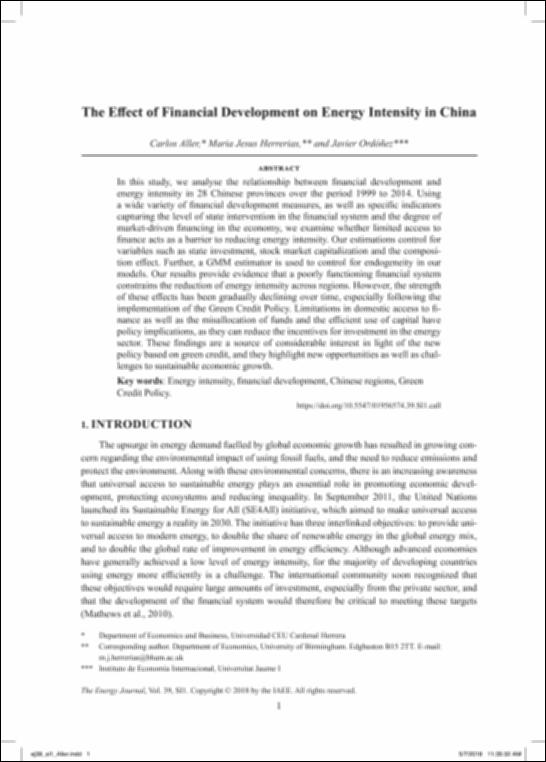Por favor, use este identificador para citar o enlazar este ítem:
http://hdl.handle.net/10637/10708The effect of financial development on energy intensity in China
| Título : | The effect of financial development on energy intensity in China |
| Autor : | Aller Arranz, Carlos Ordóñez Monfort, Javier Herrerias Talamantes, María Jesús |
| Materias: | Economic development - Environmental aspects - China.; Desarrollo económico - Aspectos ambientales - China.; Sustainable development; Recursos energéticos; Power resources - China.; Desarrollo sostenible - China.; China - Política energética.; China - Energy policy. |
| Editorial : | International Association for Energy Economics. |
| Citación : | Aller, C., Herrerias, MJ. & Ordóñez, J. (2018). The effect of financial development on energy intensity in China. The Energy Journal, vol. 39, Special issue 1, pp. 25-38. DOI: https://doi.org/10.5547/01956574.39.SI1.call |
| Resumen : | In this study, we analyse the relationship between financial development and energy intensity in 28 Chinese provinces over the period 1999 to 2014. Using a wide variety of financial development measures, as well as specific indicators capturing the level of state intervention in the financial system and the degree of market-driven financing in the economy, we examine whether limited access to finance acts as a barrier to reducing energy intensity. Our estimations control for variables such as state investment, stock market capitalization and the composition effect. Further, a GMM estimator is used to control for endogeneity in our models. Our results provide evidence that a poorly functioning financial system constrains the reduction of energy intensity across regions. However, the strength of these effects has been gradually declining over time, especially following the implementation of the Green Credit Policy. Limitations in domestic access to finance as well as the misallocation of funds and the efficient use of capital have policy implications, as they can reduce the incentives for investment in the energy sector. These findings are a source of considerable interest in light of the new policy based on green credit, and they highlight new opportunities as well as challenges to sustainable economic growth. |
| Descripción : | Este artículo se encuentra disponible en la página web de la revista en la siguiente URL: https://www.iaee.org/energyjournal/article/3202 This is the peer reviewed version of the following article: Aller, C., Herrerias, MJ. & Ordóñez, J. (2018). The effect of financial development on energy intensity in China. The Energy Journal, vol. 39, Special issue 1, pp. 25-38, which has been published in final form at https://doi.org/10.5547/01956574.39.SI1.call Este es el post-print del siguiente artículo: Aller, C., Herrerias, MJ. & Ordóñez, J. (2018). The effect of financial development on energy intensity in China. The Energy Journal, vol. 39, Special issue 1, pp. 25-38, que se ha publicado de forma definitiva en https://doi.org/10.5547/01956574.39.SI1.call |
| URI : | http://hdl.handle.net/10637/10708 |
| Derechos: | http://creativecommons.org/licenses/by-nc-nd/4.0/deed.es |
| ISSN : | 0195-6574 1944-9089 (Electrónico) |
| Fecha de publicación : | 20-nov-2018 |
| Centro : | Universidad Cardenal Herrera-CEU |
| Aparece en las colecciones: | Dpto. Economía y Empresa |
Los ítems de DSpace están protegidos por copyright, con todos los derechos reservados, a menos que se indique lo contrario.


